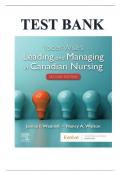, TEST |BANK |FOR |YODER-WISE’S |LEADING |AND |MANAGING |IN |CANADIAN |NURSING,
|2ND|EDITION, |PATRICIA |S. |YODER-WISE, |JANICE |WADDELL, |NANCY |WALTON,
ISBN: |9781771721684,
ISBN: |9781771721745,
ISBN: |9781771721677
Table |of |Contents
| Part |I: |Core
Concepts|Overview
|
1. Leading, |Managing, |and |Following
2. Developing |the |Role |of |Leader
3. Developing |the |Role |of |Manager
4. Nursing |Leadership |and |Indigenous |Health
5. Patient |Focus
Context
6. Ethical |Issues
7. Legal |Issues
8. Making |Decisions |and |Solving |Problems
9. Health |Care |Organizations
10. Understanding |and |Designing |Organizational |Structures
11. Cultural |Diversity |in |Health |Care
12. Power, |Politics, |and |Influence
Part |II: |Managing |Resources
13. Caring, |Communicating, |and |Managing |with |Technology
14. Managing |Costs |and |Budgets
15. Care |Delivery |Strategies
16. Staffing |and |Scheduling |(available |only |on |Evolve)
17. Selecting, |Developing, |and |Evaluating |Staff |(available |only |on |Evolve)
,Part |III: |Changing |the |Status |Quo
18. Strategic |Planning, |Goal-Setting, |and |Marketing
19. Nurses |Leading |Change: |A |Relational |Emancipatory |Framework |for |Health |and
|Social|Action
20. Building |Teams |Through |Communication |and |Partnerships
21. Collective |Nursing |Advocacy
22. Understanding |Quality, |Risk, |and |Safety
23. Translating |Research |into |Practice
Part |IV: |Interpersonal |and |Personal |Skills
Interpersonal
24. Understanding |and |Resolving |Conflict
25. Managing |Personal/Personnel |Problems
26. Workplace |Violence |and |Incivility
27. Inter |and |Intraprofessional |Practice |and |Leading |in |Professional |Practice |Settings
Personal
28. Role |Transition
29. Self-Management: |Stress |and |Time
Future
30. Thriving |for |the |Future
31. Leading |and |Managing |Your |Career
32. Nursing |Students |as |Leaders
, Yoder-Wise's |Leading |and |Managing |in |Canadian |Nursing |2nd |Edition |Yoder-Wise |Test |Bank
Chapter 01: Leading, Managing, and Following
| | | | |
Waddell/Walton: Yoder-Wise’s Leading and Managing in Canadian Nursing,
| | | | | | |
SecondEdition
| |
MULTIPLE |CHOICE
1. A |nurse |manager |of |a |20-bed |medical |unit |finds |that |80% |of |the |patients |are |older |adults. |She|is
|asked |to |assess |and |adapt |the |unit |to |better |meet |the |unique |needs |of |older |adult |patients.
|According |to |complexity |principles, |what |would |be |the |best |approach |to |take |in |making |this
|change?
a. Leverage |the |hierarchical |management |position |to |get |unit |staff |involved
|in|assessment |and |planning.
b. Engage |involved |staff |at |all |levels |in |the |decision-making |process.
c. Focus |the |assessment |on |the |unit, |and |omit |the |hospital |and
|community|environment.
d. Hire |a |geriatric |specialist |to |oversee |and |control |the |project.
ANS: | B
Complexity |theory |suggests |that |systems |interact |and |adapt |and |that |decision |making
|occurs|throughout |the |systems, |as |opposed |to |being |held |in |a |hierarchy. |In |complexity |theory,
|everybody’s |opinion |counts; |therefore, |all |levels |of |staff |would |be |involved |in |decision
|making.
DIF: Cognitive |Level: |Apply REF: |Page
|14|TOP: | Nursing |Process: |Implementation
N R I G B.C M
U |S |N |T |area |receives
|
O
| | | |
2. A |unit |manager |of |a |25-bed |medical/surgical |a |phone |call |from |a |nurse |who |has
called |in |sick |five |times |in |the |past |month. |He |tells |the |manager |that |he |very |much |wants |to
|come |to |work |when |scheduled, |but |must |often |care |for |his |wife, |who |is |undergoing
|treatment|for |breast |cancer. |In |the |practice |of |a |strengths-based |nursing |leader, |what |would |be
|the |best |approach |to |satisfying |the |needs |of |this |nurse, |other |staff, |and |patients?
a. Line |up |agency |nurses |who |can |be |called |in |to |work |on |short |notice.
b. Place |the |nurse |on |unpaid |leave |for |the |remainder |of |his |wife’s |treatment.
c. Sympathize |with |the |nurse’s |dilemma |and |let |the |charge |nurse |know |that |this
|nurse|may |be |calling |in |frequently |in |the |future.
d. Work |with |the |nurse, |staffing |office, |and |other |nurses |to |arrange |his
|scheduled|days |off |around |his |wife’s |treatments.
ANS: | D
Placing |the |nurse |on |unpaid |leave |may |threaten |physiologic |needs |and |demotivate |the
|nurse.|Unsatisfactory |coverage |of |shifts |on |short |notice |could |affect |patient |care |and |threaten
|staff |members’ |sense |of |competence. |Strengths-based |nurse |leaders |honour |the |uniqueness |of
|individuals, |teams, |systems, |and |organizations; |therefore |arranging |the |schedule |around |the
|wife’s |needs |would |result |in |a |win-win |situation, |also |creating |a |work |environment |that
|promotes |the |health |of |all |the |nurses |and |facilitates | their |development.
DIF: Cognitive |Level: |Analyze REF: |Page
|6|TOP: | Nursing |Process: |Implementation
NURSINGTB.COM




